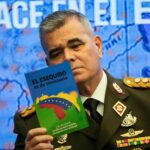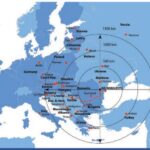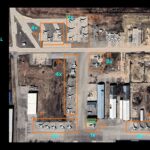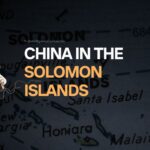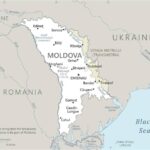INTELLIGENCE ANALYSIS – The Euphrates corridor, as any waterway in the Middle East (and not only) has been a catalyst for urban settlement, agriculture industry and energy development. Crossing Syria from its north-western corner in Aleppo governorate all the way down to Iraq’s Anbar region, the Euphrates River has been used by ISIS as a blood vein to spread as a tumor in a ravished body. Through its road to Iraq, the Euphrates also crosses the sparsely populated but oil-rich region of Deir-Ezzor; it’s importance being critical for trade, exploitation and transport optimization. Moreover, capitalizing on the strategic importance of the river and its surroundings, ISIS has made its self proclaimed-capital in Raqqa since 2014 – after it ousted the Free Syrian Army and Jabhat al-Nusra that initially liberated it in June 2013 from the Syrian Arab Army, following the escalation of the Revolution into the Civil War.
As of now, the United States is actively supporting the Syrian Democratic Forces (SDF), a multi-etnic group but which is dominated by an over-majority of Kurdish personnel from the YPG, near that region. Whilst the SDF also encompasses Arab Sunni tribesmen, Syriacs or a few Turkmens, their existence is contested by Turkey as being simply an umbrella for the Kurdish YPG. Nonetheless, they are spearheading operation Wrath of Euphrates – with the sole objective of ousting ISIS from Raqqa.
Background
Gradually, since 2016, the United States has began focusing on clearing the border region from ISIS, by supporting the Kurdish militia YPG and the multi-ethnic but Kurdish dominated umbrella group, SDF (Syrian Democratic Forces).
Operations stretched from Hasakah Governorate, bordering Iraq, to northern Raqqa Governorate and finally to west of the Euphrates: Aleppo Governorate. Reaching the last mentioned, the YPG-led SDF has liberated a jihadi stronghold, Manbij, in June 2016, announcing plans to completely oust the terror group from the Turkish border by launching assault in Jarabulus (Cerabulus tr.) and the strategic road knot of al-Bab (el-Bab tr.).
Ankara noted with concern in regards with the Kurdish expansion; by ousting ISIS from northern Aleppo and then YPG occupying the territory, the northern Kurdish cantons would have been united, further boosting the political entity established there, the Federation of Northern Syria[1] (a cover-up for the Kurdish Rojava project).
Executive Summary
The military intervention triggered by the Turkish Armed Forces and its local proxies, as the Turkmen Syrian Brigades, FSA groups and the Islamist Ahrar ash-Sham, on August 24th 2016, addressed the Kurdish enlargement by ousting the border region from ISIS and occupying it with own forces and friendly assets. Starting from there, Ankara established a wider buffer zone in which 24,000 Syrian refugees from Turkey have been re-settled[2] whilst also engaged in post-conflict resolution, such as re-building cities, bringing administration back to life etc.
The intervention has secured Ankara with an unmovable seat at the negotiations table, in regards with Syria’s future. Furthermore, the SDF and YPG were operationally checked, and faced constant threats from Turkey, while the militias had no leverage over them. The Loyalist camp tolerated the intervention due to a Russian-Turkish pact in which Ankara renounces its support for the Rebels fighting in the Siege of Aleppo.
Moreover, the United States, understood the security concerns of Turkey, and faced with a degradation of the historical strategic partnership after the failed Coup, Washington ordered a Kurdish retreat to east of the Euphrates, which the YPG complied with. Even though the military element was then gone from west of the Euphrates, the Manbij Military Council, which was set by the SDF/YPG, was still there and had full political control and legitimacy.
The “Wrath of Euphrates”
Finally, in October 2016 the Pentagon has re-purposed the SDF, accelerating the Coalition’s plans against ISIS. They launched operation “Wrath of the Euphrates” with the objective of liberating Raqqa[3]. The intricately planned operation stipulated several phases to complete before commencing with an actual assault on the city. The main pre-assault pillars are the following:
- Cutting supply roads to Raqqa
- Isolating rural Raqqa from the city, and
- Isolating Raqqa city from the outside world, by encirclement and imposing a siege.
Yet, the operation had several delays, especially due to Turkey’s protests. After liberating al-Bab in February 23th 2017, the Turkish Armed Forces (TSK) demanded a leading role for their proxies in the Raqqa offensive with the sole condition of excluding the SDF and YPG from it[4]. While talks were held between the Chiefs of Staff in late February, Turkey’s strong-armed the US-led Coalition by shelling and attacking Manbij.
The Manbij Military Council, established by the SDF/YPG after the liberation of Manbij, has called for the Loyalist camp to block Turkey’s incursions, and transferred land west of Manbij to Russian protectorate[5]. Moreover, fearing that a Turkish attack on Manbij will sabotage or at least cause a delay for the Raqqa operation, the US has deployed the 75th Ranger Regiment, US Army soldiers in Manbij, in order to deter Ankara’s advancements[6]. Consequently, with America’s firm stance with the SDF/YPG and Russia’s blockade in western Manbij, Turkey was operationally checked. “[Combined Joint Task Force Operation Inherent Resolve] has taken this deliberate action to reassure coalition [members and] partner forces, [and] deter aggression and keep focus on defeating ISIS,” Colonel Dorrian said, speaking for the Coalition.
As a result, Ankara ended the operation on March 30th, concluding that the mission was a success[7]. The 6,000 square km buffer zone, stretching from Jarabulus to Azzaz on the border and as deep as al-Bab and Tadef in Syrian territory was enough to satisfy Turkey’s security interests, but not sufficient to strategically weaken the SDF/ YPG, as Manbij is still intact and the Kurds have not retreated to east of the Euphrates. However, with the end of “Euphrates Shield” many of Rebel fighters have been diverted to Idlib where they joined the Tahrir al-Sham (ex-Jabat Fateh al-Sham, ex- al-Nusra, Al-Qaeda in Syria) offensive towards the city of Hama. The territory will be further controlled by the Police Force established in Turkey to patrol the streets of northern Aleppo Governorate, and by the Syrian Turkmen Brigades, who also have a significant presence there. The Turkish Armed Forces is also expected to station several assets, especially as reports from February suggest that a military base will be established on Aqil hill in al-Bab.
In effect, the end of this operation does equal the end of Turkish ambitions in Syria. And given the negative exit from the war-room, alienated by both the US and Russia, Turkey seems to renew its support for a regime change, even fueling the offensive led by Tahrir al-Sham. But as even Turkish Prime-Minister Binali Yildirim pointed out: “another military operation can be launched if needed“.
With Turkey’s “official” ending of the operation “Euphrates Shield”, the Coalition and local partners could now focused entirely on ISIS. Yet, the containment of ISIS forces in Raqqa has proven to be difficult. The jihadists began moving fighters and capabilities from the “capital” since early 2017, when they launched a blitz offensive on the Regime enclave of Deir-Ezzor. While the isolated Syrian Arab Army, supported by air by the Russian Air Force, have managed to fight off the attacks, their situation is still questionable; especially that for the jihadists, it’s enough to conquer the airstrip used for resupply in order to break the defenses. Moreover, the jihadists are also making an escape to Iraq’s Anbar region. The hypothesis that ISIS senior leaders have already left Raqqa for al-Qa’im, Anbar, Iraq, has been confirmed by the US air strike that killed al-Baghdadi’s second-in-command, Ayad Al-Jumaili, the “Minister of War”[8]. The senior leader was killed in al-Qa’im, Iraq. Of course, he, as all of the top commanders of ISIS or of ex-Al-Qaeda in Iraq are ex-Ba’athists from Saddam Hussein’s government.
Therefore, an additional challenge for the SDF/YPG and US is not only to isolate the jihadists, but also to contain them in Raqqa; block any means of escape and reduce the chance of spreading afterwards.
Within the Raqqa offensive, the SDF and YPG have developed two parallel sub-fronts:
- West: focuses on the Raqqa-Aleppo supply corridor, centered around the eastern shores of Lake Assad and consequently on Tabqa, the city, the dam and the airfield; and
- East: focused on cutting the roads and villages connecting Raqqa to Deir-Ezzor, and beyond it, in Iraq. The fights are concentrated along the banks of the Euphrates.
Each two had different intensities and characteristics. The eastern sub-front was by far more efficient, as the SDF is at just 5 km from the north-eastern periphery of the Raqqa. However, no breaching can occur just yet, not until the western sub-front also reaches the city. As of now, the eastern sub-front has shut the Raqqa-Deir-Ezzor in several places, and is close to completely cut the corridor.
Shurfa and Tabqa Dam
The western sub-front has underpinned several interesting episodes in the past two weeks. In early March, the SDF/YPG combo was on the northern shores of Lake Assad; slowly fighting towards the Euphrates and Tabqa Dam, yet the resistance was strong. It was also around that time when the Pentagon launched a surge in troop numbers, deploying an additional 400 forces in Syria[9] and also planning to dislocate 1,000 reservists in Kuwait, ready to quickly replace wounded soldiers on the battlefield[10]. Among 1st Special Forces Operational Detachment-Delta, 75th Ranger Regiment, the Expeditionary Force of the US Marines Corps was also spotted in Syria.
https://www.youtube.com/watch?v=ohhLrC1Rji8
On the night between March 21st and 22nd, the United States launched an airborne operation, airlifting hundreds of SDF and YPG forces to the south-eastern shores on the Lake. The swift behind-enemy-lines operation captured Shurfa peninsula and managed to cut the supply corridor from Raqqa to Aleppo Governorate by taking control of the Aleppo-Raqqa 4th road. The western sub-front now stretched from the northern shore of Lake Assad, to the south-eastern one[11].
Consequently, forces remaining on the northern shores moved eastwards and took control of most of the Tabqa Dam (Thawrah Dam). The dam is a critical piece of infrastructure that keeps the water levels in the Euphrates stable and produces electric energy. It controls 13 billion square meters of water in a lake, which derives from the Euphrates River. The dam is 60 meters high and 4.5 kilometers long being the largest dam in Syria. Its construction led to the creation of Lake Assad, Syria’s largest water reservoir. It was constructed between 1968 and 1973 with the help from the Soviet Union.
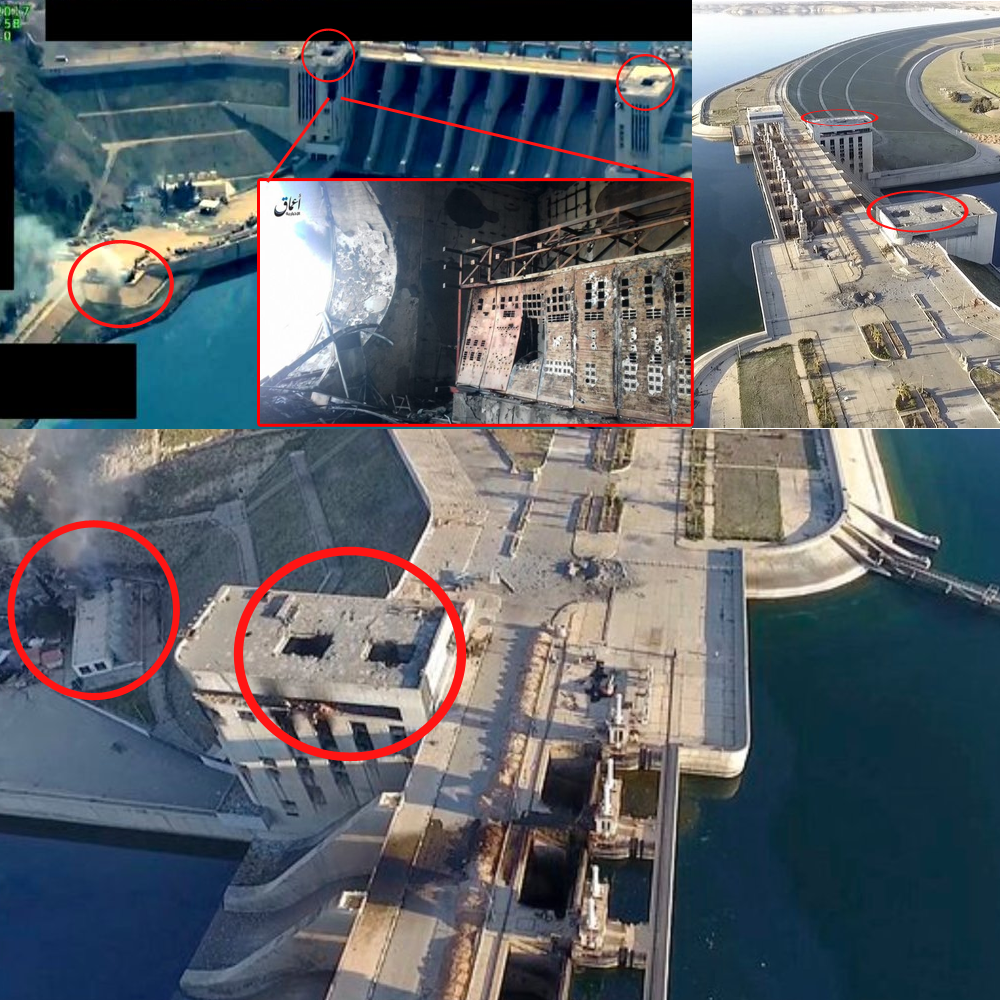
ISIS launched a massive propaganda campaign saying that the Dam is going to fail due to Coalition airstrikes. Whilst the Dam did indeed take damage, it was far from being in critical failure. On March 27th operations paused around the Tabqa Dam so that SDF forces could send a crew of experienced, Syrian engineers and the Syrian Red Crescent to carry out repairs which returned the spillways to functioning capacity, and relieved the pressure on the dam[12].
Expanding the tool-kit: Tabqa Airfield in US hands
Hallmarks of the enhanced US capabilities in Syria are the tactical assets obtained or established locally. The “tool-kit” stretches from airstrips, clandestine units and multi-level cooperation. While most of the fighter jets take off the Incirlik Air Base in Turkey or from aircraft carriers in the Persian Gulf, the air assets that directly support the clandestine Special Operations in Syria are Syrian-based.
On March 27th, the SDF and YPG have captured the Tabqa airfield, located just south of the city with the same name, and at 45 km west of Raqqa[13]. The military airport was captured by ISIS in August 2014 from the Regime. On that take-over, almost 160 Regime soldiers were killed and another 200 were taken as “prisoners of war”, surely a concept that does not apply in the case of ISIS. The terrorists’ later executed all of them.
Kurdish officials hope that the liberation of the airport would make the US-led coalition less dependent on the Incirlik Air Base in south-eastern Turkey. Previously Ankara has repeatedly threatened to close it down due to US cooperation with the Kurdish-led SDF troops and for the alleged support for the pro-Coup soldiers. The SDF and the US-led coalition could use the airport to facilitate the flow of good, supplies and personnel. This could accelerate the liberation of Raqqa and move the campaign forward.
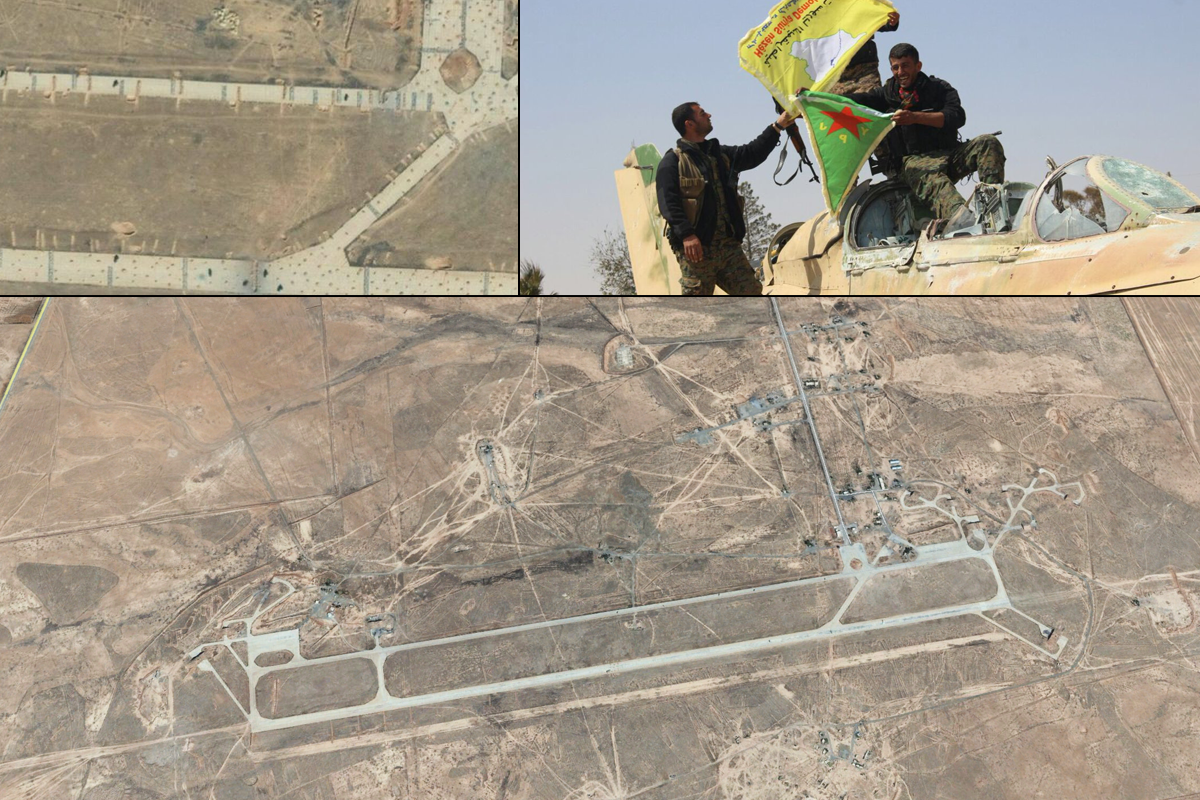
up-left: aerial view of the damage inflicted by ISIS into the runways; up-right: YPG/ SDF forces on a destroyed Mig-29 in Tabqa airfield; lower-half: aerial view of Tabqa airfield
The capture of Tabqa airfield comes as the U.S.-led coalition has been quietly increasing its aerial capability in northern Syria to include more landing areas and bases for taking the fight to ISIS[14]. Tabqa airfield could play a decisive role as Qayyarah air base did in Iraq for the Mosul operation. The conditions are also similar, as ISIS trashed the airfield in order to make it unusable, even though US engineers will definitely repair it.
However, U.S. military officials and SDF commanders told VOA that an airbase in Kobani will be the headquarters for U.S.-led coalition operations to retake Raqqa[15]. Located at 110 km north of Raqqa, near the Turkish border, the Kobani airbase is the largest from all the other airstrips the US has in northern Syria: Abu Hajar airport, Hasakhe and Sarrin.
Regardless, these assets can never measure up to the strategic level of the Incirlik Air base, which is also a NATO base used by the United Kingdom, Germany and Turkey and regional allies as Saudi Arabia or Qatar. Moreover, the US presence in northern Syria is in an unconventional level and is criticized by the Bashar al-Assad government that still claims sovereignty and control over all of country.
A Last Siege: Taqbah
Taqbah city, or al-Tahrawh, is a small city that before the war consisted of 60,000 people; it is now under ISIS control and sits between the Taqbah Dam and Taqbah Airfield. With the US-led Coalition advancement on the 4 Aleppo-Raqqa road, in full speed, the SDF and YPG have taken a left-turn into the surrounding villages.
On March 31st and April 1st, clashes have already erupted in the villages of Ibad (Abad) and As Safsafah, just east of Taqbah. It is clear that the Coalition now intends to cut any outside links with Taqbah in order to liberate the city and eliminate the strongest pre-Raqqa enemy defense. Moreover, ousting the jihadists from the area will consolidate US-led Coalition’s control over the Dam, further securing it, whilst majorly advancing the offensive.
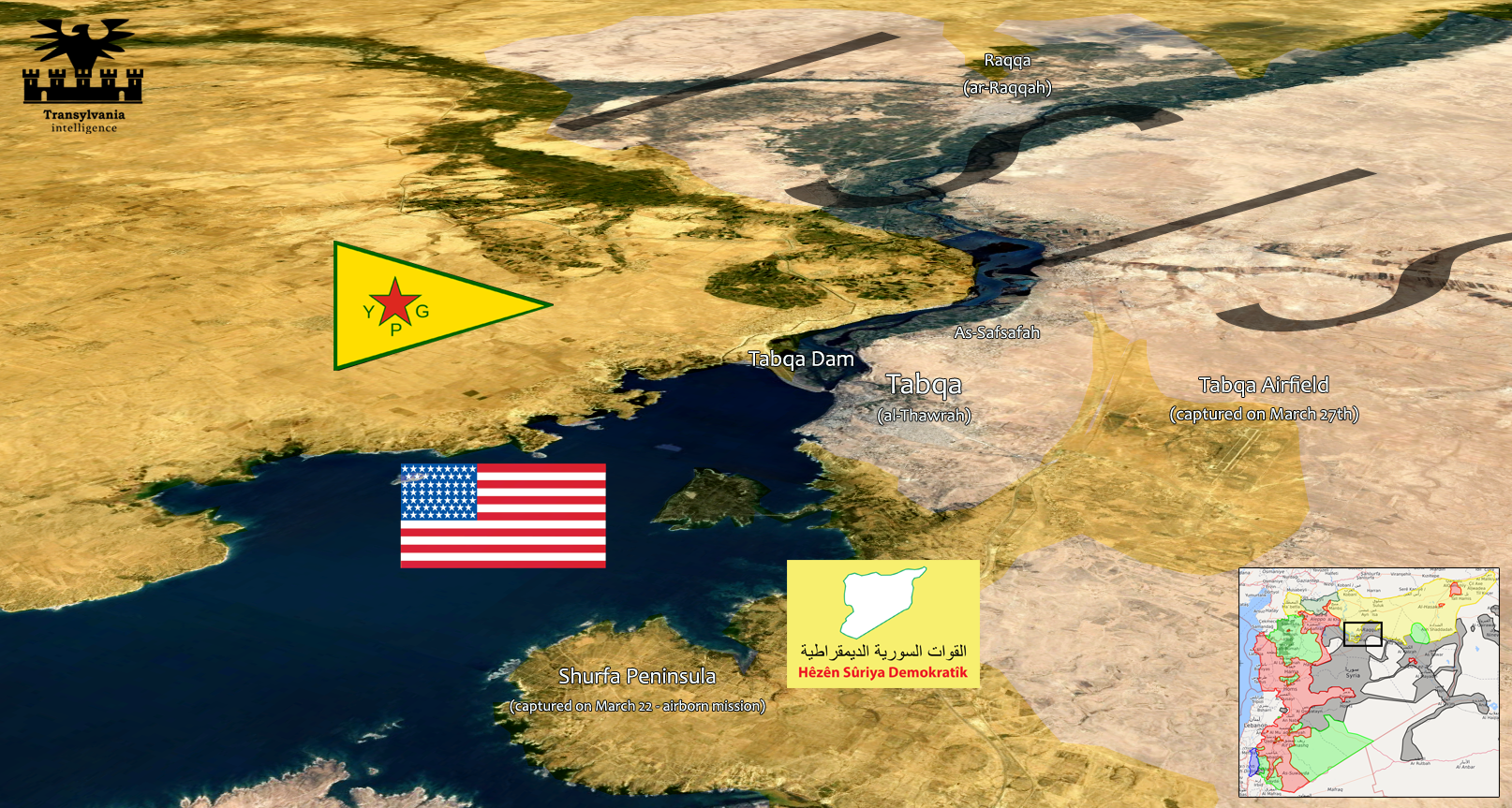
operational map as of April 1st 2017
The SDF says it will hand control of Raqqa to a mostly Arab civilian council once it is captured, in line with the city’s demography. In addition, the SDF has engaged in local recruiting in order to boost the Arab component of their forces. On March 31st, 220 fighters recruited from Raqqa through partnerships with local tribes, have graduated the Martyr Faysal Abu Leyla’s Academy Training Courses in Kobane[16].
“War Pigs” for Raqqa
President Trump, who campaigned on a pledge to expand the fight against the militants in Syria, Iraq and beyond, received an extensive plan from the Pentagon for combating ISIS[17]. The strategy calls for significant U.S. military participation, including increased Special Operations forces, attack helicopters and artillery, and arms supplies to the main Syrian Kurdish and Arab fighting force on the ground. The proposal would also ease a number of restrictions on U.S. activities imposed during the Obama administration and would relax the rules of engagement (ROE) – already seen. The information reported by the Washington Post is consistent with the lately troop surge in Syria and the easing of R.O.E, as even Kurdish fighters admit:
“Regarding the coalition, they are providing air and ground support in this campaign and the help is better than in the previous occasions, offering weapons that we did not have before,” she said[18].
According to Debka’s military sources, the US has also detached troops from Iraqi Kurdistan to Syria, following the winding down of the Mosul fight[19]. On March 28, a large convoy of trucks, with the KRG numbers plates of the semiautonomous Kurdish government of Iraq, crossed into Syria at the Semalka border post. Some were heavily laden with arms and ammunition; others hauled armored personnel carriers.
The reported estimated number of the SDF, together with YPG, is around 60,000 soldiers. In Iraq, the assault on Mosul needed double the number and the fight is still ongoing in its seventh month. And as the Debka analysis also points out, the lack of tanks for the operation is a troubling factor. A Turkish involvement would have provided with sufficient armored assets as they already have dozens, if not over a hundred tanks spread around their safe zone.
As a balancing policy, Washington restrained from supplying the Syrian Democratic Forces (SDF) with tanks, fearing that such a weapon’s transfer would prompt a Turkish military attack on the Kurds. Just by a quantitative analysis through crowd sourcing we can conclude the vehicles provided by the US are Humvees, bulldozers and Oshkosh Joint Light Tactical Vehicle (JLTV).
Even with the enhanced American presence on the ground, the Syrian airfields, or the diversity of air assets (bombers, cargo planes, transport helicopters, attack helicopters, fighter jets etc.), the assault on Raqqa still needs ground support capability (artillery) for an armored infantry charge.
Whether the Trump administration would send US armored divisions or eventually supply the SDF with tanks, it remains to be seen, but until this issue is addressed, the assault on Raqqa is operationally shorthanded.
Outlook
On the other hand, the developments around the Euphrates corridor are at full speed and for the several weeks there have been no setbacks. The US-led Coalition has the initiative which translates in swift consecutive losses for the jihadists.
Emphasizing the sustained effort on the Western sub-front, the developments east of Raqqa are equally important, where completely cutting any link with Deir-Ezzor and Iraq would fully isolate and imprison the jihadists in their self-proclaimed “capital”.
The Trump administration and James Mattis have proven to be highly efficient in their political-to-military response. Most of the credit goes to Secretary of Defense “Mad Dog” Mattis, who has received extended autonomy for decision making from Trump, as reported. The steadfast and urgency of deploying, mission launching and war planning, the pro-active military diplomacy with regional actors, as well as the successfully passing of the first major challenge (the Turkish-Kurdish tensions for Manbij) have facilitated a convenient environment for efficiently advancing towards Raqqa.
The battle for Raqqa is expected to commence in the following weeks, and would last at least several months. Liberating Raqqa would utterly degrade the conventional capabilities of Da’esh, forcing it into a rural insurgency mostly centered on the Syrian-Iraqi border and the sparsely populated afferent desert.
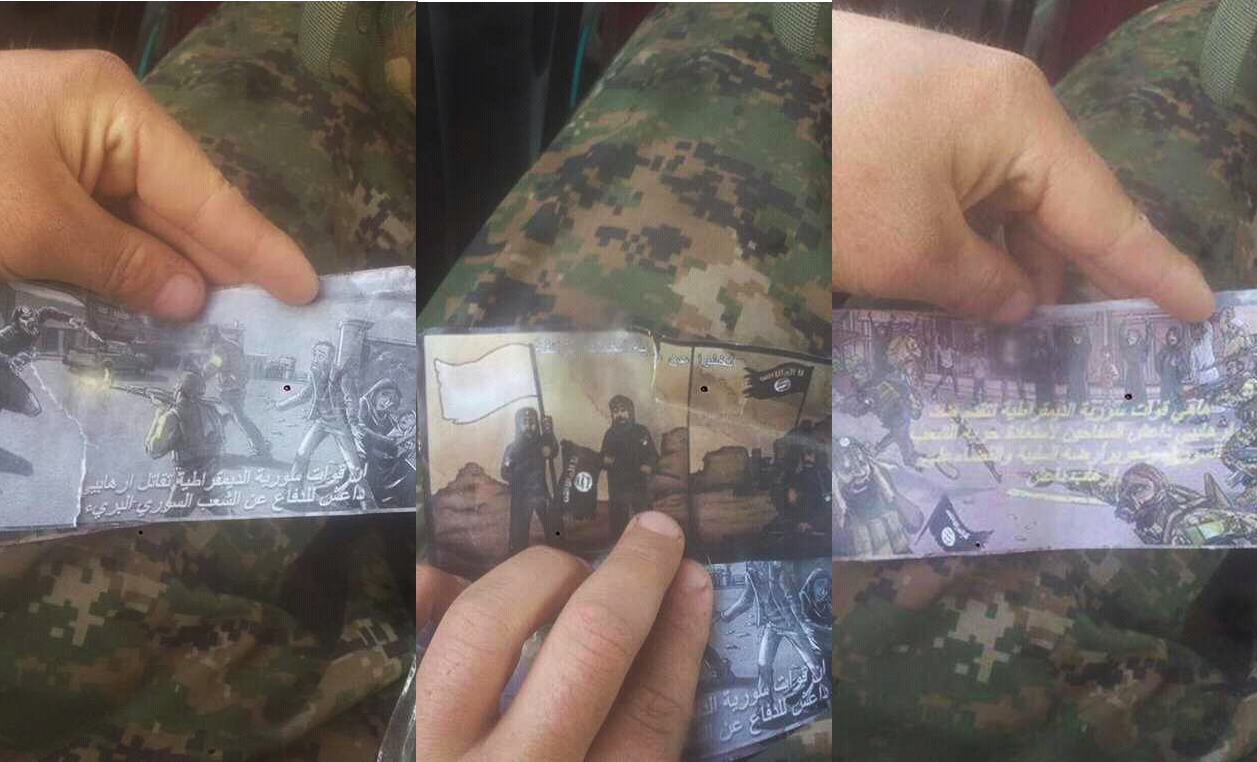
SDF soldiers shows leaflets air dropped in Raqqa to inform the civilian population that the Coalition will assault the city to liberate it from ISIS
Bibliography
[1] „Syria civil war: Kurds declare federal region in north”, https://www.aljazeera.com/news/2016/03/syria-civil-war-kurds-declare-federal-system-north-160317111902534.html
[2] „Some 24,000 Syrians back home in Jarabulus from Turkey”, Anadolu Agency, https://aa.com.tr/en/middle-east/some-24-000-syrians-back-home-in-jarabulus-from-turkey/725921
[3] Williams, Sara Elizabeth, „«Wrath on the Euphrates» as US-backed forces launch operation to seize Raqqa from Isil’s grip”, The Telegraph, https://www.telegraph.co.uk/news/2016/11/06/us-backed-forces-announce-operation-to-seize-raqqa-from-isils-gr/
[4] „Turkey insists on exclusion of Kurdish forces from Raqqa battle”, Al-Monitor, https://www.al-monitor.com/pulse/ru/originals/2016/11/turkey-insists-exclusion-of-kurds-from-raqqa.html
[5] Sputnik, „Kurds Shed Light on Russia-Damascus Deal to Prevent Turkey’s Attack on Manbij”, https://sputniknews.com/middleeast/201703061051312686-manbij-syria-russia-deal/
[6] „US-led coalition sends troops to Manbij to deter ‘aggression’”, Rudaw, https://www.rudaw.net/english/middleeast/syria/040320171
[7] „End of Euphrates Shield, says Turkish Security Council”, https://aa.com.tr/en/todays-headlines/end-of-euphrates-shield-says-turkish-security-council/782781
[8] „Islamic State’s deputy «killed in airstrike»”, Sky News, https://news.sky.com/story/islamic-state-deputy-ayad-al-jumaili-killed-in-air-strike-iraq-says-10821290
[9] Gordon, Michael R., „U.S. Is Sending 400 More Troops to Syria”, The New York Times, 9 march 2017, https://www.nytimes.com/2017/03/09/world/middleeast/us-troops-syria.html
[10] „Exclusive: U.S. weighs deploying up to 1,000 «reserve» troops for IS fight”, Reuters, 8 martie 2017, https://www.reuters.com/article/us-usa-trump-islamicstate-exclusive-idUSKBN16F2SK,
[11] Kelly, Fergus, „SDF and US special forces air-dropped near Taqba, west of Raqqa, Syria • Grasswire”, Grasswire, https://www.grasswire.com/2017/03/sdf-us-special-forces-air-dropped-near-taqba-west-raqqa-syria/
[12] „US-backed Syria forces pause operations near Tabqa dam”, https://www.aljazeera.com/news/2017/03/backed-syria-forces-pause-operations-tabqa-dam-170327112107511.html
[13] „Tabqa Military Airport in Northern Syria liberated by Freedom fighters | English”, https://www.ypgrojava.org/Tabqa-Military-Airport-in-Northern-Syria-liberated-by-Freedom-fighters
[14] „US-led Coalition Boosting Airfield Capabilities in Syria”, VOA, https://www.voanews.com/a/us-led-coalition-increasing-airfield-capabilities-in-syria/3791891.html
[15] ibidem
[16] „ANF | Ajansa Nûçeyan a Firatê”, https://www.anfenglish.com/news/220-more-youths-from-raqqa-join-sdf-ranks
[17] „Pentagon plan to seize Raqqa calls for significant increase in U.S. participation”, Washington Post, https://www.washingtonpost.com/world/national-security/pentagon-plan-to-seize-raqqa-calls-for-significant-increase-in-us-participation/2017/03/04/d3205386-00f3-11e7-8f41-ea6ed597e4ca_story.html
[18] „U.S.-backed assault on Raqqa to last months, commander says”, Reuters, 31 martie 2017, https://www.reuters.com/article/mideast-crisis-syria-raqqa-idINKBN17218T
[19] „With Turks out, Raqqa operation is short of tanks”, https://www.debka.com/article/25992/With-Turks-out-Raqqa-operation-is-short-of-tanks?utm_source=dlvr.it&utm_medium=facebook
Founder of T-Intelligence. OSINT analyst & instructor, with experience in defense intelligence (private sector), armed conflicts, and geopolitical flashpoints.

